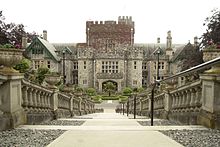Royal Canadian Naval College
 |
|
| Motto | Truth, Duty, Valour |
|---|---|
| Type | Military college |
| Established | 1940 |
| Chancellor | David Collenette (1993-1995ex-officio as Minister of National Defence) |
| Principal | Dr. John J.S. Mothersill (1984-1995) |
| Commandant | Captain (N) David B Bindernagel (1994-1995) |
|
Administrative staff
|
N/A |
| Undergraduates | 200+ |
| Location |
Victoria, British Columbia, Canada 48°26′04″N 123°28′22″W / 48.43444°N 123.47278°WCoordinates: 48°26′04″N 123°28′22″W / 48.43444°N 123.47278°W |
| Campus | Hatley Park |
| Closed | 1995 |
| Website | rrmc.ca |
 |
|
| Location | Hatley Castle, on the campus of the Royal Roads University |
|---|---|
| Website | www.rmc.ca/other/museum/index_e.html (Official) |
Royal Roads Military College (RRMC) was a Canadian military college (1940 to 1995) located in Hatley Park, Colwood, British Columbia near Victoria, British Columbia, Canada. The facility is currently being used as the campus for Royal Roads University, a public university that offers applied and professional academic programs on campus and via distance education. The centrepiece of the campus is Hatley Castle, constructed by architect Samuel MacLure in the early part of the 20th century for B.C. coal baron James Dunsmuir and his wife, Laura. The house had been purchased as a wartime residence for the King, Queen, and their daughters.
The property owned by industrialist James Dunsmuir, along with his mansion Hatley Castle, was acquired by the Dominion Government in 1940. The initial plan was that the site would be used to house the British royal family during World War II. However, as the Queen Mother put it, "The children will not go without me and I will not go without the King and the King will never go".
Designed to support Canada's naval war effort, the facility began operating in December 1940 as an officer training establishment known as HMCS Royal Roads. Many of the 600 volunteer reserve officers who underwent training during this time served in the Battle of the Atlantic. HMCS Royal Roads was used to train short-term probationary Royal Canadian Navy Volunteer Reserve (RCNVR) sub-lieutenants to serve in World War II.
In 1942, because of wartime expansion, the Royal Canadian Naval College was established. In 1947, the facility became known as the RCN-RCAF Joint Services College where Royal Canadian Navy and Royal Canadian Air Force personnel were trained. The facility changed its name to Canadian Services College, Royal Roads in 1948 where personnel from all three services - the Navy, Air Force, and Army were trained during a two-year program.
...
Wikipedia
